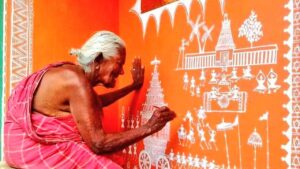Ganesha the supreme godhead is the symbol of wisdom and understanding. His presence brings security that gives us the hope to live a life with dedication and love. But what does his presence hold in our beloved art element?
Well, the answer surely rests within the beautiful creations every artist creates. As to paint Lord Ganesha is no lesser than reinvigorating the positive energy and portraying generosity through every touch of the brush. And so, by mixing such graceful features I found this hidden gem named Kaavi Art.

About Kaavi Art
The smell of seashore, the calm and sturdy waves, and the luscious seafood, ah! What a pleasant vibe Goa holds. And not just the feel but the hidden heritage of Kaavi art this city carries just makes me awestruck!
Kaavi Art is a historical art form in Konkan term kaav means the Indian red pigmentation, which is the only color used in this art form gained out of laterite soil. This art form’s unique trait is the technique of the application; the red paste is applied to the white walls to give out an artistic impression.




Kaavi Art- Made with Love! Shaped in Tradition
If you’re pondering over the material for Kaavi art, then imagine a Goan beach where you’ll discover the snow-white lime is being obtained by burning the sea shells, and washed sand from the river bed mixed with jaggery is fermented for over two weeks. This mixture is hand poured to obtain a smooth substance that later hardens and is applied to the walls giving our eyes the beauty of Kaavi wall art.
Ganesha and Kaavi Art
Many temples in the pre-Portuguese era were rich in Kaavi art. And so is the reason why Lord Ganesha’s Murals are splendid in many of the temples of Goa. Talking about inspiring Lord Ganesha has also influenced the carpenter community here. Many Goan temples have a portrait of Ganesha which is crafted with utmost grace.

“Goa used to be known once for its skilled wood carving. The carpenter communities in most villages had inherited this form of art. However, only a few temples showcase it today. There is a need to protect and conserve this tangible cultural heritage of our land.”
-Sanskruti Naik, fine art instructor.
Source- The Times of India.




